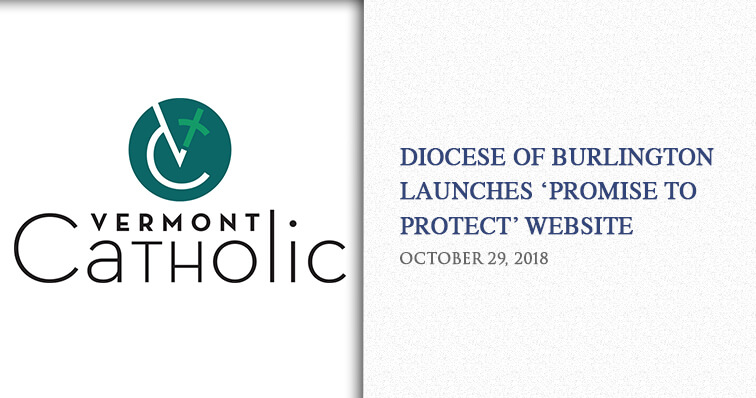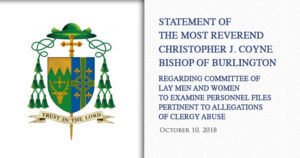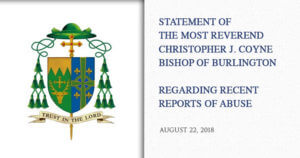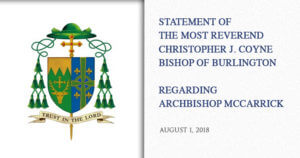The sins of the past
The Diocese of Burlington this week published a report listing the names of diocesan clergy who, since 1950, have had a credible and substantiated allegation of sexual abuse of a minor made against them. With one exception, all of these acts occurred more than 20 years ago. None of these priests are in ministry; most of them are deceased. While most of these allegations took place at least a generation ago, the numbers are still staggering; the victims of these priests are still bearing the wounds of what happened to them. Until now, the scope of all of this has been our “family secret.”
Family secrets can be toxic. Harmful past experiences — unspoken, unaddressed, and known only by a few — fester like neglected wounds. The innocent victims of the family secret are often made to feel ashamed about what happened as no one seems to listen to them or even, sadly at times, believe them. While these secrets remain hidden, those who have been hurt are often unable to find the healing they need, especially if those who harmed them are still “part” of the family, even if only in memory.
The Church is not immune to this reality. We often talk about the Church as a family, as a community of faith in which we are brothers and sisters in our love for God the Father, Son and Holy Spirit. We are supposed to be a people of love, a place of hope, and a community of healing. But that is not always the case. This is especially true with the significant number of cases involving the sexual and physical abuse of children by clergy, not just here in Vermont, but in the entire Church. These “sins of the past” continue to haunt us. These shameful, sinful and criminal acts have been our “family secret” for generations. While there has been significant action by the Church here in Vermont and in the United States to address the issue of the sexual abuse of minors by clergy and the cover-up of those crimes by those in authority, the whole sordid tale of what happened in decades leading up to the U.S. bishops’ 2002 Charter for the Protection of Children and Young People has not been fully aired. That is why I have asked that this report be compiled and published.
When I arrived in Vermont four years ago as the 10th bishop of Burlington, I promised to continue the Diocese’s efforts to address past abuses of children by clergy, to work toward healing for those who have experienced abuse, to maintain a zero-tolerance policy for any individual with a substantiated allegation of sexual abuse, and to be transparent about the prevention, handling, and response to the sexual abuse of minors. In order to do so, it is clear to me that we must be fully honest about these sins of our past. If only a list of priests with credible allegations of sexual abuse of a minor had been released 15 years ago, perhaps we would be farther along our collective path of healing. But for many reasons, this was not able to happen.
In November 2018, as part of my personal commitment and that of the Diocese of Burlington to transparency regarding abuse by clergy, an independent, volunteer committee of four lay men and three lay women assembled to review clergy personnel files pertinent to any past allegation of abuse of a minor and to create a list of priests who have been credibly accused of sexually abusing a minor. Working completely independent of the Diocese, the committee only met with me twice, in the beginning and at the end of the process. I am grateful to the individuals who served on the file review committee, volunteering more than eight months of their time to thoroughly review files and materials and to compile a report of their findings. As promised, I am publishing the committee’s report as it was presented to me without any edits or changes. The report and information about the committee members can be viewed at vermontcatholic.org/promise.
In addition to confronting the sins of the past, we must remain vigilant in ensuring these sins do not occur in the future. I have listened to the stories of victims of clergy sexual abuse and will continue to do so. They need to hear over and over again that we believe them. They also need to know that we are doing everything we humanly can to make sure this does not happen again. The Church in the United States has put in place policies and procedures to make the Catholic Church one of the safest places for children today. In 2002, the Diocese of Burlington adopted the Charter for the Protection of Children and Young People, which requires: mandatory reporting of all abuse allegations to civil authorities; removal of credibly accused clerics from active ministry; background checks of all priests, staff and volunteers; training to recognize and prevent abuse; and many other proactive steps to ensure the safety of all members of our Church family. A Diocesan Review Board meets regularly as the preeminent consultative body to review our programs and policies and to work with the Bishop to ensure adherence to the Charter.
As a result of our rigorous efforts, since 2002 there has been only one credible and substantiated claim of abuse against a priest in the Diocese of Burlington. There are no priests in ministry in Vermont who have had a credible and substantiated allegation made against them.
As has been the case for the past 17 years, I, along with the clergy, staff and volunteers of the Diocese, are committed to supporting and caring for all victims of abuse and will continue to work to ensure safe environments for all God’s people — especially children, youth and vulnerable individuals— in which no form of harassment, sexual or otherwise, is tolerated. If you have been abused or if you suspect a minor or vulnerable person has been abused, contact the proper authorities immediately, including local law enforcement and the Diocese’s Victim Assistance Line at 866-485-2488.
Please visit vermontcatholic.org/promise for regular updates, frequently asked questions and more information regarding the Diocese’s promise to protect children and vulnerable persons entrusted to our care.
The greater family of the Catholic Church is in much need of healing. Together, we can mend our family’s discord and, by the grace of God, ensure that these sins do not happen again.
Yours in Christ,
![]()
The Most Reverend Christopher J. Coyne
Bishop of Burlington
Our Track Record
Annual averages over the last 12 years (2005–2018).
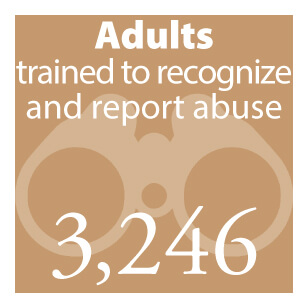


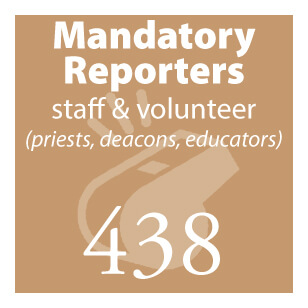
Our Diocese has made a promise to protect the children entrusted to our care and a pledge to heal those who have experienced abuse by clerics or other Church personnel. Under the guidance and direction of the United States Conference of Catholic Bishops (USCCB) and the Secretariat of Child and Youth Protection, the Diocese of Burlington works alongside other Dioceses in the nation to ensure that the Catholic Church in the United States adheres to a zero-tolerance policy when it comes to child abuse and neglect.
In 2002, the Roman Catholic Diocese of Burlington adopted the USCCB approved Charter for the Protection of Children and Young People and made a pledge to adopt all 17 articles that address the following:
- Mandatory reporting of all abuse allegations by individuals who experienced sexual abuse by some cleric or other Church personnel to civil authorities;
- Cooperation with civil authorities;
- Removal of credibly accused clerics from active ministry;
- Background checks of all priests, staff and volunteers;
- Training of all clergy and staff to recognize and prevent abuse;
- Training for children to recognize, prevent and report abuse;
- Healing and reconciliation;
- Accountability in procedures.
The Office of Safe Environment Programs was established to protect children and young people by establishing “safe environments” in the present and future. Dedicated staff ensure that all policies of the charter are followed across the Diocese in our parishes, schools and ministries. Dioceses are audited annually by an independent auditing firm to ensure continuous accountability and to help avoid complacency in the vital task of protecting God’s children. Each year, the findings of all audits are summarized in an Annual Report on the Implementation of the Charter, which is prepared by the Secretariat of Child and Youth Protection.
As a result of our rigorous efforts over the last 16 years, there has been only one credible and substantiated claim of abuse with an 18-year-old who formed an emotional relationship that began when the victim was a minor. There are no priests in ministry who have had a credible and substantiated allegation made against them.
Beyond these fundamental steps — which are still in place today — the Diocese continues to be focused on outreach to all survivors of sexual abuse by clergy. In 2003 the Diocese established the Victim Advocacy Group with the specific mission of aiding in the healing process for those who have been harmed. This work now is accomplished through the victims assistance coordinator. The coordinator strives to provide timely assistance to individuals who have been abused by Church personnel, and all information shared with the coordinator is strictly confidential. The coordinator also meets with victims personally upon request.
As your bishop, I promise to protect our children from harm and pledge to heal the wounds of those abused by clergy, and to work with faithful lay men and women to purify and transform our Church into the source of salvation intended by God.
Office of Safe Environment Frequently Asked Questions
In response to the sexual abuse crisis by clergy and other Church personnel, the Diocese of Burlington has joined with its fellow Dioceses to condemn these past abhorrent behaviors and to take effective action to prevent such abuses from occurring in the future. To guide this nationwide effort, the United States Conference of Catholic Bishops (USCCB) established the Charter for the Protection of Children and Young People in June 2002. The charter is a comprehensive document comprised of 17 articles that outline the Church’s commitment to:
- mandatory reporting of all abuse allegations to civil authorities;
- cooperation with civil authorities;
- removal of clerics from active ministry;
- promotion of healing and reconciliation;
- accountability in procedures; and
- protection of children and young people by establishing “safe environments” in the present and future.
To fulfill the requirements set forth by the charter, each Diocese and Archdiocese has dedicated office personnel who are tasked with the duty of implementing it, and in the Diocese of Burlington this duty falls to the Office of Safe Environment Programs, in conjunction with the vicar general.
The United States Conference of Catholic Bishops established the Charter for the Protection of Children and Young People in June 2002. The charter is a comprehensive document comprised of 17 articles that outline the Church’s commitment to:
- mandatory reporting of all abuse allegations to civil authorities;
- cooperation with civil authorities;
- removal of clerics from active ministry;
- promotion of healing and reconciliation;
- accountability in procedures; and
- protection of children and young people by establishing “safe environments” in the present and future.
To fulfill the requirements set forth by the charter, each Diocese and Archdiocese has dedicated office personnel who are tasked with the duty of implementing it, and in the Diocese of Burlington this duty falls to the Office of Safe Environment Programs, in conjunction with the vicar general.
Dioceses, Archdioceses and Eparchies in the United States are audited annually by an independent auditing firm to assess compliance with each of the articles of the charter. During the most recent audit, the Diocese of Burlington was found compliant with all articles of the charter.
Beyond the requirements of the charter, the Diocese of Burlington has its own unique set of policies that are designed to ensure that children and vulnerable adults are protected from harm while under the care of the Catholic Church in Vermont. The policies are referred to as the Policies on Ethics and Integrity in Ministry. The Office of Safe Environment Programs is tasked with enforcing these policies throughout the Diocese and teaching Church representatives about proper implementation.
In summary, the Office of Safe Environment Programs was established to ensure national and local child safety standards are always adhered to with the highest level of integrity. Numerous smaller tasks make up this larger effort, and everyone at each parish and Catholic school has a distinct role to play in child abuse prevention in the Diocese. These tasks are delegated, coordinated, organized and led by the committed staff of the Office of Safe Environment Programs.
Each year (a year spanning from July 1 to June 30 of the following year), U.S. Dioceses and Archdioceses are audited by an auditor to assess whether they are compliant with the guidelines of the charter. The audit is conducted by an independent national auditing firm contracted by the United States Conference of Catholic Bishops (USCCB).
Currently, the USCCB has chosen StoneBridge Business Partners from Rochester, New York, as the primary auditor for all Dioceses, Archdioceses and Eparchies in the United States. In preparation for our annual audit, the Diocese of Burlington gathers all its child safety training, victim outreach, clergy, staff and volunteer information from parishes and Catholic schools from that particular audit year. This collected information stands as the culmination of our efforts to establish safe environments throughout the Diocese of Burlington, and it exemplifies the efforts of the parishes and Catholic schools who contribute to the sacred mission of child safety. All our collected documents are submitted to our auditors each year, and they determine if our Diocese is compliant with the charter. Some of the information we submit on an annual basis includes the total number of children and adults trained on ways to identify, prevent and report abuse and the total number of adults who have been background checked. By submitting to an annual audit, US bishops continue to hold themselves accountable to fulfilling the mission of protecting God’s children.
The Diocese of Burlington has been found compliant with the Charter for the Protection of Children and Young People since 2007. During our most recent audit, the Diocese of Burlington again was found to be compliant by StoneBridge Business Partners.
Since these new policies have been enacted, there has been only one credible and substantiated claim of abuse with an 18-year-old who formed an emotional relationship with a priest that began when the victim was a minor. There are no priests in ministry who have had a credible and substantiated allegation made against them.
In 2002-2003, priest files containing a credible allegation of clergy between 1950 and 2000 were turned over to the state attorney general. The allegations of sexual abuse by diocesan priests currently in the news involve abuse occurring decades ago and before the Church adopted its current protection policies in 2003.
As part of the effort to protect children and youth from abuse in the present and onward, the USCCB’s Charter for the Protection of Children and Young People mandates that all adults who work with minors undergo a background check. Article 13 of the charter specifically covers this background check requirement by stating:
“Dioceses/eparchies are to evaluate the background of all incardinated and non-incardinated priests and deacons who are engaged in ecclesiastical ministry in the diocese/eparchy and of all diocesan/eparchial and parish/school or other paid personnel and volunteers whose duties include ongoing, unsupervised contact with minors. Specifically, that are to utilize the resources of law enforcement and other community agencies. …”
Therefore, to fulfill our obligation to the charter, the Diocese of Burlington has policies in place that require that all adults who work with minors undergo a background check BEFORE engaging in ministry. Beyond the requirements of the Charter, the Diocese of Burlington has gone a step further in our background-check efforts by stating that all background checks must be renewed every five years to adequately reassess suitability for ministry on a regular basis.
The Diocese reruns all background checks on a five-year basis to track any changes in an individual’s criminal record since the last time he or she underwent a background check. If the Diocese only ran one single background check for each person, it would have no way of knowing whether the person has been convicted of any criminal activity since being hired or starting as a volunteer.
The safe environment training for adults is mandated by the USCCB’s Charter for Protection of Children and Young People under Article 12. Article 12 of the charter states:
“Dioceses/eparchies are to maintain ‘safe environment programs’ which the diocesan/eparchial bishop deems to be in accord with Catholic moral principles. They are to be conducted cooperatively with parents, civil authorities, educators, and community organizations to provide education and training for children, youth, parents, ministers, educators, volunteers and others about ways to make and maintain a safe environment for children and young people. Dioceses/eparchies are to make clear to clergy and all members of the community the standards of conduct for clergy and other persons in positions of trust with regard to children.”
Therefore, to fulfill our obligation to the charter, the Diocese of Burlington is presently using the Virtus program by the National Catholic Services, LLP to serve as the primary program used to educate adults who serve minors. The Virtus program teaches adults how to build healthy relationships with children, and it teaches them how to assist a child who has been harmed by abuse, neglect, bullying or some other form of harassment/intimidation. Based on Catholic moral principles, courses offered through the Virtus program cover a variety of issues in child safety including child abuse prevention, the practices of professionalism and Internet safety. By completing the program, adults will learn how to interact with youth appropriately, and they will learn how to provide help to a young person who is struggling with a difficult situation.
To provide safe environments for the children and youth entrusted to our care, the Diocese of Burlington requires that all adults who serve minors complete annual youth protection training. While a simple, one-time training may seem convenient, it would fail to cover the vast range of child safety issues in our society today. There is an abundance of topics to cover in child safety, and there is new research being published all the time, and one training would not be enough to cover all of this important information. By offering annual trainings, we can cover a wider variety of child safety issues beyond abuse and neglect including bullying, cyberbullying and Internet safety. As new research is published, we can also incorporate the findings into our annual trainings by editing our courses to make them as up-to-date as possible. One-time training would not be able to provide users with the same quantity of material or keep them updated with the latest findings.
Additionally, a one-time training would not be enough to keep us engaged in the welfare of children over the long term. By requiring training annually, we avoid complacency by always keeping child safety on the forefront of everyone’s mind. Through these annual trainings we also are reminded of the importance of being vigilant and trusting our instincts when something doesn’t look or feel right. Without these annual trainings, our knowledge of child protection would become outdated and eventually forgotten. In summary, the more educated we are in child protection issues, the safer children will be under our watch and care. Our children are precious gifts from God, and we cannot afford to shortcut child protection education for mere convenience.
The safe environment training for children and youth is mandated by the USCCB’s Charter for Protection of Children and Young People under Article 12. Article 12 of the Charter states:
“Dioceses/eparchies are to maintain ‘safe environment programs’ which the diocesan/eparchial bishop deems to be in accord with Catholic moral principles. They are to be conducted cooperatively with parents, civil authorities, educators and community organizations to provide education and training for children, youth, parents, ministers, educators, volunteers and others about ways to make and maintain a safe environment for children and young people. Dioceses/eparchies are to make clear to clergy and all members of the community the standards of conduct for clergy and other persons in positions of trust with regard to children.”
Therefore, to fulfill our obligation to the charter, the Diocese of Burlington has chosen the Circle of Grace program as the primary program used teach children and youth about healthy relationships and boundaries. However, parishes and Catholic schools may choose to use other additional programs promulgated by the bishop as well. The Circle of Grace curriculum is designed to teach children about appropriate boundaries and to help them feel comfortable communicating with their parents or other trusted adults when something isn’t right. In summary, we want to give children the tools to help prevent abuse before it has occurred or to report abuse if they’ve experienced it. The curriculum of the program accomplishes this goal by underscoring God’s love for all of us and by focusing on the Catholic teachings regarding the dignity of the human person. We hope the lessons learned from the curriculum equip children with the tools to cultivate healthy, abuse-free relationships throughout their lives.
Circle of Grace is a safe environment program for children and youth that is designed for use both in Catholic schools and in parish religious education programs. The program follows a traditional lesson-plan format, and it fits in best to a classroom-style learning format. Developed by the Archdiocese of Omaha, the Circle of Grace is the fruit of collaboration among clergy, principals, teachers, school counselors, directors of religious education, catechists, youth ministers and mental health professionals. Sound in content and methodology, the program is designed for kindergarten through grade 12.
Circle of Grace’s curriculum is steeped in the truths of the Catholic faith and provides a holistic approach to the safety, wellbeing and spiritual formation of children and youth. It was introduced in the Diocese of Burlington in the 2013-2014 academic and catechetical year, and it is used annually as the primary safe-environment curriculum for children and youth in the Diocese.
An independent, lay, file review committee began meeting in early November. Before reading any files, committee members tried to establish rules and guidelines to follow. The committee set what turned out to be an unrealistic deadline for finishing all the file reading by Dec. 31, 2018. Once the committee saw the personnel files – some of them 1,000 pages or more – they knew it would take many more months.
While there has been significant action by the Church to address the issue of the sexual abuse of minors by clergy and the cover-up of those crimes by those in authority, the entirety of what happened in decades leading up to the U.S. bishops’ 2002 Charter for the Protection of Children and Young People had not been fully aired. These “sins of the past” continue to haunt us. In an effort to facilitate healing for victims and transparency on behalf of the Church, the Bishop asked that this report be compiled and published.
It is an effort to help foster the process of healing and restoration of trust in the Church. This list also serves to notify the public about accused priests who have been laicized or dismissed to help address any risk to children that they may currently pose. Publication of a list may cause harm to the legacy of accused perpetrators, but the list also may offer some long-missed consolation to victims and their families and friends. It is just one small step that might offer healing.
The names published are those found to have a credible and substantiated allegation of abuse, based on the criteria determined by the file review committee.
The committee considered several standards and agreed to adopt the standard used by the Roman Catholic Diocese of Syracuse, New York, to guide decisions on finding a priest credibly accused of sexual abuse of minors. The committee believed it was the most fair to both victims and the accused. The committee agreed “credible” is defined as: An allegation, based on facts of the case, that meets one or more of the following thresholds: Natural, plausible and probable; Corroborated with other evidence or another source; or Acknowledged/admitted to by the accused.The committee determined there must be at least – a “fair probability” – based on the information given, that a particular priest had either sexually abused a child under the age 18 or created a “substantial risk” that the child would be sexually abused. For the purposes of the Vermont report, a “credible allegation” is not the equivalent to a finding of “probable cause” by a judge or grand jury in a criminal case.
Priests who have been “laicized” no longer have any rights or obligations of Holy Orders (for example, most sacraments and celibacy), and the Diocese no longer has any obligations of sustenance or support, or any responsibility of oversight toward that cleric.
Priests who have admitted to having sexually abused a minor may be “sentenced” by the Holy See in Rome to a life of “prayer and penance” if they are not suited for dismissal due to their age or infirmity. Priests assigned to a life of prayer and penance are permanently restricted from all forms of public ministry and may not wear clerical attire or publicly identify themselves as priests.
Priests who are “absent from ministry” also are restricted from all forms of public ministry and may not wear clerical attire or publicly identify themselves as priests.
The diocese designated a Victim Assistance Coordinator with the specific mission of aiding in the healing process for those who have been harmed. The Victim Assistance Coordinator strives to provide timely assistance to individuals who have been abused by Church personnel, and all information shared with the Victim Assistance Coordinator is strictly confidential. The Victim Assistance Coordinator, in conjunction with the Office of Safe Environment Programs, helps facilitate healing by:listening to an individual’s story;providing counseling referrals;guiding individuals through the reporting process;supporting affected family members and friends; andby promoting prayer opportunities throughout the Diocese to support those who may be struggling. To contact, call (802) 855-3016.
Wider Church
A Call for transparency
The revelations about Archbishop McCarrick’s sexual sins and infidelity, and the Pennsylvania investigation is extremely disheartening. The sins of our past in our own Diocese and revelations of new allegations outside of our Diocese need to be addressed through complete transparency so we can we purify our Church and grow in the grace and knowledge of our Lord and Savior Jesus Christ.
“Sanctify them through thy truth: thy word is truth.” (Jn 17:17). We are all called to spread the truth that Jesus Christ is the son of God and the way, the truth and the life. The horrible sin of abusing minors and the abuse of power by cardinals, bishops or priests over a long period of time are evil. We must purge ourselves of past sins and seek healing and closure for survivors.
That is why I am recommending that all Dioceses voluntarily open their clergy personnel files — including those of bishops — to investigators.
While our Diocese turned over files containing a credible allegation of clergy to the state attorney general in 2002, in the name of transparency, I am forming an independent committee of lay men and women to examine clergy personnel files pertinent to any allegation of abuse of minors and to create a list that will be made public.
Let us pray: O God may you restore to us the joy of Your salvation and sustain us with a willing spirit.
A Call for Clarity about steps taken to prevent abuse
Every announcement and discussion of clergy abuse is quite painful and potentially re-traumatizing for survivors and their families. We remain committed to investing resources to care for the survivors and ensure that the perpetrators are prevented from carrying out further abuse.
Since 2002, locally and nationally, we have made great strides to create one of the safest places for children but what we haven’t done well is help the public, our parishioners, or even the media to understand the facts about our track record here in Vermont or across the Church in the U.S. As a result of our rigorous efforts over the last 16 years, there has been only one credible and substantiated claim of abuse with an 18-year-old who formed an emotional relationship that began when the victim was a minor. There are no priests in ministry who have had a credible and substantiated allegation made against them.
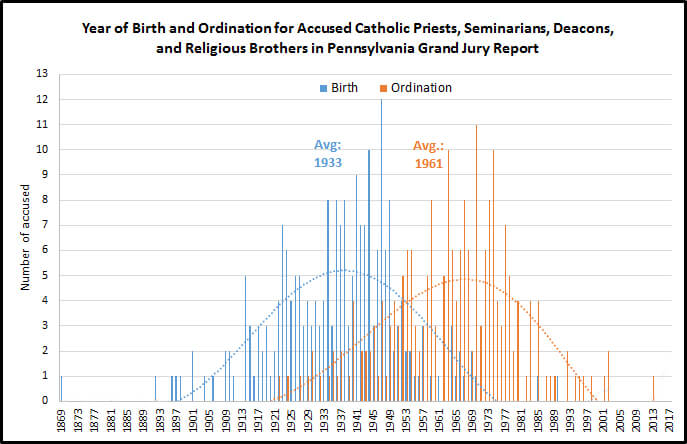
Pennsylvania Grand Jury Report ignores drastic decrease in allegations beginning in 1970’s
The above graph presents data assimilated from the Pennsylvania Grand Jury report that measures the number of accused priests against their birth years and the years they were ordained. What it shows is that the average year many of the priests accused of sexual abuse were born was 1933, and the average year they were ordained was 1961. As the graph shows, the number of accused priests in Pennsylvania began to drop at the end of the 1970’s and continued to do so until the present. Interestingly, the data on this graph mirrors the revelations of a 2004 study conducted by researchers at the John Jay College of Criminal Justice in which they aggregated the number of allegations of clergy sexual abuse of minors from 1950 to 2002. If the research is anything to go by, the profile of priests alleged to have sexual misconduct with minors has not changed in the 14 years since the 2002 sex abuse crisis hit the Church, meaning we are dealing with the ramifications of a scandal that has largely passed, not a new one.
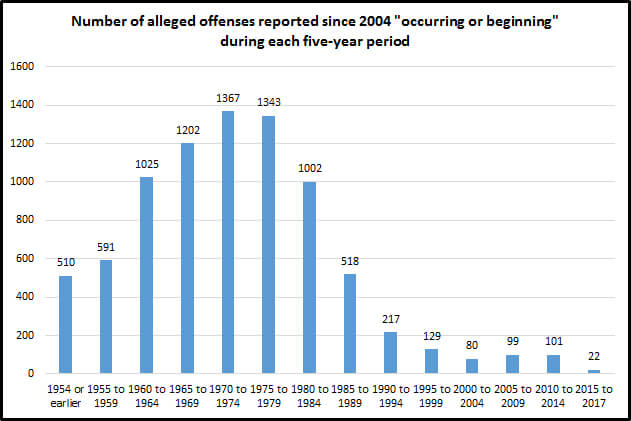
CARA study shows the same drastic decrease in allegations across the United States
This graph presents data aggregated by the Center for Applied Research in the Apostolate (CARA) representing the number of alleged cases of clergy sex abuse of minors during each five-year period from 1950 up through 2017. This data is for the entire U.S. Church, and it is for allegations that have been reported since 2004. (Note: The reported date and the alleged incident date are often decades apart). As the graph shows, new abuse allegations have not disappeared altogether — there were 22 that were reported to have occurred during this most recent five-year period we’re in — though they have dropped significantly. This is still far too many — zero should be the only acceptable figure. However, to give these numbers some context, consider that 42 teachers in the state of Pennsylvania lost their licenses due to sexual misconduct in 2017 alone. This is no excuse for what has happened in the Church; rather, these statistics put into proper context all the diligent work the Catholic Church has done and continues to do at preventing sexual abuse in its institutions and shows that it is committed to purging this evil from its ranks.
*Graphs and analysis from Archdiocese of Denver: https://promise.archden.org/#widerchurch



